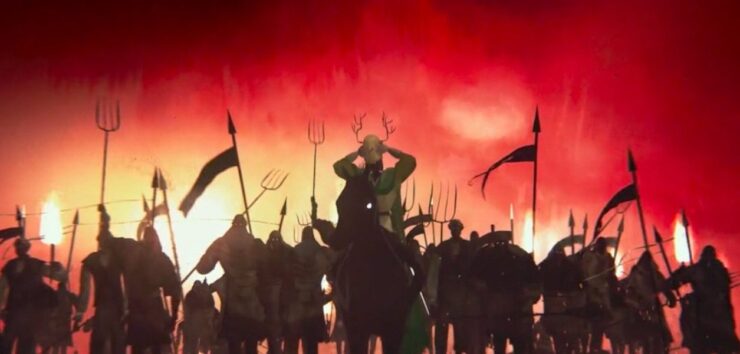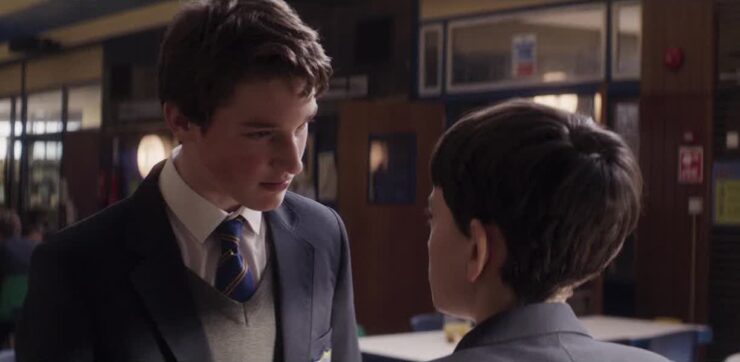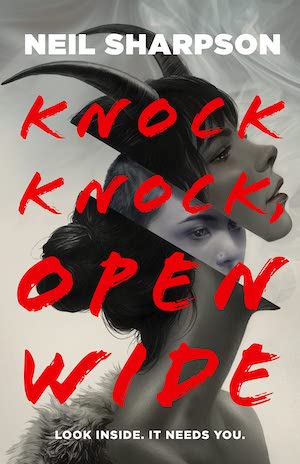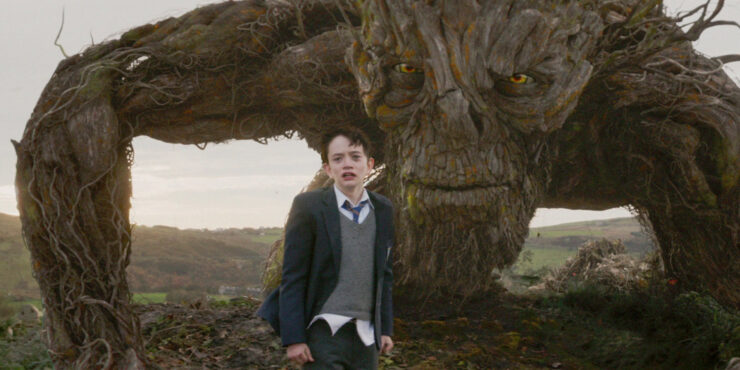Think of all the personifications of unrepentant evil that exist in fantasy media: Voldemort and Sauron; Darth Vader, Scar, and Darkseid; the Borg and the Daleks. They are creatures distilled from the darkest of human impulses, entities of such compelling malevolence that they could not possibly exist in the real world. Only within our imaginings could such beings dwell; only within our nightmares could they reign supreme.
I would now like to add another impossible villain to the pantheon: A Monster Calls’ Harry.
Harry is a school bully. For the purposes of A Monster Calls (2016), he exists to make the life of the film’s protagonist, Conor O’Malley, a living hell. But Harry (James Melville) is a very special kind of demon: a soft-voiced, reflective, terrifyingly thoughtful sociopath, whose beatings are all the worse for the measured calculation with which they’re delivered. (In the original novel—set in modern-day England and written by Patrick Ness, inspired by ideas originated by the late author Siobhan Dowd—he’s sketched out more fully as the school’s “Wonder Child,” the teacher’s pet, great at everything he attempts, and tacitly acknowledged, at least among the staff, as one righteous little shit.)
And it isn’t as if Conor (Lewis MacDougall) doesn’t have enough anguish. His mother (Felicity Jones) is fighting a losing battle with cancer, and is more out of his life—bedridden, hospitalized, or just plain too incapacitated to interact—than in. His maternal grandmother (Sigourney Weaver)—a cold, strict woman—has her hands full tending to her daughter, and nurses a bitter resentment for how Conor’s father (Toby Kebbell) abandoned his wife for a new life (and a new wife) in America, a resentment that extends to Conor.
On top of that, there are nights when, at 12:07, a towering yew tree in the neighboring churchyard stirs to life, assumes a massive, humanoid form, and confronts Conor. On the first meeting, the Monster (voiced by Liam Neeson) issues an ominous challenge: It will visit the boy three times, tell him three tales, and then Conor will have to tell the Monster a story of his own, a story that speaks to his truth. If Conor fails at the task, he will be devoured.
Dark stuff. Seriously dark stuff. Stuff so dark that it was a perfect fit for director J.A. Bayona, who had previously garnered attention with the disturbing ghost story The Orphanage. Unfortunately, while the producers of A Monster Calls—including Participant Media, a studio better known for such socially conscious projects as Steven Spielberg’s Lincoln and Al Gore’s documentary/PowerPoint presentation An Inconvenient Truth—made the right call in bringing the Spanish director in, the marketing departments of U.S. distributor Focus Features lacked the vision to see what a powerful work had landed in their laps. A Monster Calls got a limited release at end of 2016—presumably as a Hail Mary pass for awards consideration—before being undeservedly condemned to the dumping grounds of a January 2017 wide release.

But make no mistake, putting Bayona in charge was the right call. He is able to frame Conor’s suffering without turning the boy into a martyr—while in the book Conor is more aggressive in how he rebuffs the Monster, in the film he shows enough backbone to not fall into the trap of victimhood. The grandmother’s harshness is portrayed without her devolving into Wicked Witchiness; and the love Conor and his mother share, despite the specter that hangs over them, is heartbreakingly envisioned.
And Bayona loads tons of atmosphere into the film. That especially goes for the stories the Monster tells, two CG animated sequences done by Glassworks VFX in a stylized, storybook style that contains echoes of the celebrated Czech stop-motion animator Jirí Trnka. As befits tales spun by a Monster, they are not soothing bedtime stories, but parables teeming with suffering, death, and moral ambiguities.
[This is as good a time as any to let you know that, moving forward, we will be dealing with significant spoilers.]
In one tale, an heroic prince flees his kingdom with the love of his life—a humble farmgirl—rather than be wedded to his stepmother, the queen; he is then compelled to seek vengeance on the woman when he discovers his love has been brutally slain. In the other, when the children of a village’s parson fall ill, the clergyman is forced to approach an apothecary he had previously denounced for the man’s greed and cruelty, only to be rebuffed by the healer. In both cases, the Monster inserts itself into the stories, and in both cases, to Conor’s dismay, the creature rises to the defense not of the tales’ perceived heroes, but their ostensible villains.
The Monster’s stories are cruel; no more so than in the way the sentient yew tree obscures crucial details, and how those details shape the way it responds. But it’s cruelty with a purpose, deployed upon a boy being dragged too soon out of the innocence of childhood into the complexities of real life. A boy who needs to learn that not every story gets tied up in a neat bow, that endings are often far messier, and that a protagonist’s motivations can dwell between the realms of shadow and light, even if the protagonist is one small, frightened boy.
And weirdly, Harry, the shrewd, sadistic bully, may understand that better than does even Conor. In Harry’s last encounter with his victim, he reads the boy with devastating accuracy: “All you’re looking for is someone to kick your head in,” he tells his victim. He then shakes Conor’s hand, and delivers the killing blow: “Now you’re invisible to me.”
Remember how I nominated Harry as a fitting candidate for the roster of fantastic monsters? This is my reason: I don’t think a bully like Harry could exist in actuality. The intelligence, the insight, the—dare I say it?—empathy that courses through the character is not compatible with the forces of fear and inadequacy that tend to drive real-world bullies. In the end, Harry is not an otherworldly monster for what he does to Conor, but what he doesn’t do: Fulfill a role in Conor’s inner narrative, become the torturer Conor feels he deserves. Which may be why Conor, spurred on by the third tale the Monster whispers into his ear—a tale simply about an invisible man who no longer wishes to be invisible—promptly beats Harry to a pulp so bloody he winds up in the hospital.

What’s noted in the film, but maybe better expressed in the novel, is Conor’s sense of isolation. The entire school knows about his mother, and the response is to treat the boy with kid gloves (in the book, it is one of Conor’s best friends who spreads the news, furthering his sense of betrayal). But what others intend as acts of sympathy only traps Conor with a growing sense of guilt. His grandmother barely reacts when he trashes her sitting room, including a treasured, antique clock. In the aftermath of Harry’s beating, the school’s principal only briefly ponders Conor’s expulsion, before backing off. “How could I do that and consider myself any kind of teacher?” It’s the right answer, but from Conor’s point of view, it is also completely wrong.
And here’s where Harry—vicious and perceptive—has it all over the adults and classmates in Conor’s life. He sees what Conor needs, what Conor wants, and in his final act of cruelty, denies it to him. Only to have the Monster step in, and turn torture to mercy.
Conor has had a recurring nightmare, invoked throughout the film: His mother is standing in the churchyard as the earth opens up under her feet. Conor goes to rescue her, grabbing her hand as she dangles over the pit. But try as he might, he can’t hold on, and the dream ends just as he loses his grip. Now the Monster arrives, demanding his end of the bargain: The three stories have been told, it’s Conor’s turn, and his story is the nightmare, lived out to its conclusion.
Buy the Book


Knock Knock Open Wide
But “conclusion” has multiple meanings: Not just the end to a narrative, but a final understanding of why a narrative resolves the way it does. What the Monster seeks from Conor is not only having him witness his mother dragged to oblivion, but compelling him to acknowledge the excruciating truth of what losing her would mean: release. Escape from the shadow of inevitable death, an end to the pretense that his mother’s tale could finish any other way. For all the monsters assailing Conor from without, the boy instinctually senses the one within, one built of the warring impulses of terror over losing the person who matters most in his life, and the all-too-natural desire to want an end to pain—both his mother’s and, significantly, his own. And like The Wolfman’s Larry Talbot, he cannot live with that beast, strives to have it exterminated—by whatever means—and cannot understand why those around him, save the most improbable bully ever portrayed in literature or on screen, will not punish him for the abomination he feels dwells inside.
It falls to the capital-M Monster—the towering, walking, talking yew tree, the one whose tales defy easy resolution—to offer clarity: That the atrocity Conor believes himself to be is nothing of the sort; that he is merely a human struggling with a burden that no one—child or adult—could possibly bear. With that understanding, Conor is liberated from the crushing weight of his own denial, is able to finally let his mother go, and to ultimately deal with the loss.
The original novel of A Monster Calls ends with Conor saying farewell to his mother. The film, for which Patrick Ness himself wrote the screenplay, adds an additional scene showing Conor leafing through an art book created by his mother as a child, and discovering that she might have been visited by the Monster as well. It provides a bittersweet, lyrical ending to the film, but in some ways feels to me a little like a cheat, taking an internal, emotional journey and making it external through literalization. But maybe what Ness was going for was to carry his story beyond the journey of one fictional boy and bring it closer to us, making it universal. At one point or another, we live out the war between our empathetic selves and our psychic compulsion for survival. As with the Monster’s tales, as with Conor’s own, there are rarely clear victors and obvious losers. Best we can hope for is that we emerge from the battle with our wounds minimized and find ourselves better people for having survived. A Monster Calls presents itself as a child’s fantasy, but it’s a tale whose moral reaches beyond the bounds of childhood.
* * *
I’d be lying if I said I wasn’t devastated by A Monster Calls, or that I’m unsympathetic to the marketers who had to promote this “family” film in an entertainment ecology filled with singing Trolls and gibberish-spewing Minions. IMHO, one of the most beautiful, emotionally powerful fantasy films in existence has yet to receive the attention and praise it deserves. I don’t fancy myself a major influencer—for one thing, Hello Fresh hasn’t contacted me about a sponsorship—but I do hope I can bring more eyes to this film. I’m only human, though (ern’t we all?), so if you feel I’m overselling A Monster Calls, or have any other thoughts on the film or the novel, please feel free to use the comments section below. And as always, keep things cordial—you’ll feel better about yourself afterwards.
Dan Persons has been knocking about the genre media beat for, oh, a good handful of years, now. He’s presently house critic for the radio show Hour of the Wolf on WBAI 99.5FM in New York, and previously was editor of Cinefantastique and Animefantastique, as well as producer of news updates for The Monster Channel. He is also founder of Anime Philadelphia, a program to encourage theatrical screenings of Japanese animation. And you should taste his One Alarm Chili! Wow!










